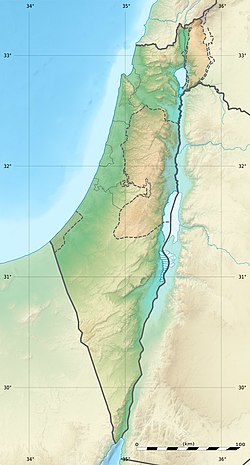Tabun Cave
 Tabun Cave | |
| Location | Mount Carmel, Nahal Me'arot Nature Reserve |
|---|---|
| Region | Israel |
| Coordinates | 32°40′13.80″N 34°57′55.80″E / 32.6705000°N 34.9655000°E |
| History | |
| Periods | Lower Paleolithic and Middle Paleolithic |
| Cultures | Mousterian |
| Associated with | Neanderthal |
| Site notes | |
| Excavation dates | 1929, 1967 |
| Archaeologists | Arthur Jelinek |

The Tabun Cave is an
History
Together with the nearby sites of
The cave was occupied intermittently during the
Deposits
The earliest and lowest
The upper levels in the Tabun cave consist mainly of clay and silt, indicating that a colder, more humid climate prevailed as glaciers formed once more; this change yielded a wider coastal strip, covered by dense forests and swamps. The material remains from the upper strata of the cave are of the Mousterian culture (about 200,000 - 45,000 years ago). Small flint tools made of thin flakes predominate these levels, many produced using the Levallois technique. Tools typical of the Mousterian culture feature elongated points, and include flakes of various shapes used as scrapers, end scrapers and other denticulate tools used for cutting and sawing.
The large number of fallow deer bones found in the upper layers of the Tabun cave may be due to the chimney-like opening in the back of the cave which functioned as a natural trap. The animals may have been herded towards it, and fell into the cave where they were butchered.[citation needed]
Several fossils were discovered at Tabun cave, including a nearly complete female skeleton (Tabun C1) and a mandible (Tabun C2). The taxonomic attributions of the two fossils are still[when?] discussed.[6][7][8][9]
Archaeologists also discovered 350,000-year-old cobble at the Tabun cave, which was used by hominids for abrading surfaces.[10]
Gallery
-
Homo Neanderthalensis, Tabun 1, Mount Carmel, Israel About 120,000–50,000 BP (replica)
-
Five hand axes, excavated 1929-1934, British Museum
-
Production of points & spearheads from a flint stone core,Mousterian culture, Tabun cave, 250,000–50,000 BP
See also
- List of fossil sites
- List of hominina fossils
- Skhul Cave
- List of caves in Israel
References
- ^ "Nahal Me'arot Nature Reserve". National Parks and Nature Reserves. Israel Nature and Parks Authority. Retrieved 7 September 2020.
- ^ "Sites of Human Evolution at Mount Carmel: The Nahal Me'arot / Wadi el-Mughara Caves". World Heritage List. UNESCO. Retrieved 7 September 2020.
- ISBN 9781407304304.
According to Jacquetta Hawkes, Yusra acted as foreman in charge of picking out items before the excavated soil was sieved; over the years, she became expert in recognising bone, fauna, hominid and lithic remains and had spotted a tooth which led to the crushed skull. Hawkes remembered talking to Yusra about coming up to Cambridge. "She had a dream. She was very able indeed. Yusra would obviously have been a Newnham Fellow." The villages of Jeba and Ljsim were destroyed in 1948 and most members of the Palestinian team could not be traced.
- ISBN 9780199645701. Retrieved 7 March 2017.
herding at Tabun cave.
- . Retrieved 7 March 2017.
- S2CID 43229427.
- ^ Coutinho Nogueira, Dany (2019). Paléoimagerie appliquée aux Homo sapiens de Qafzeh (Paléolithique moyen, Levant sud). Variabilité normale et pathologique (phdthesis) (in French). Université Paris sciences et lettres. p. 201.
- JSTOR 23383575.
- ISBN 978-3-319-46644-6.
- ^ "Stone found in Israel is oldest known tool in world used for 'delicate' abrading". The Times of Israel. 27 December 2020.





